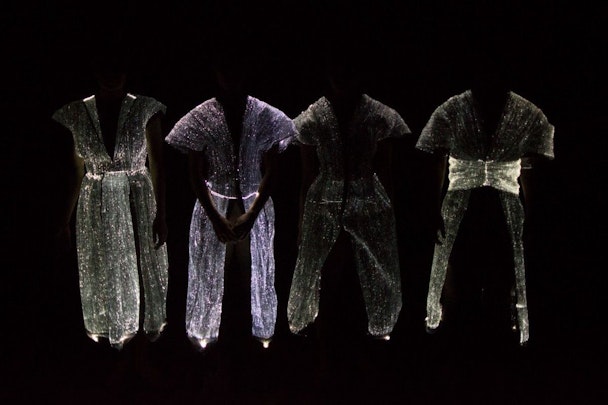Lufthansa overcomes internal turbulence to modernize the flying experience at 35,000 feet
One of SXSW’s coolest brand activations took place 35,000 feet in the sky, courtesy of Lufthansa’s FlyingLab. But it’s not always been smooth sailing – the airline’s innovation arm has had to overcome a number of internal obstacles to reach this point.

A Lufthansa plane was plunged completely into darkness for the FlyingLab
German airline Lufthansa’s FlyingLab – literally, a branded innovation lab that flies – has taken to the air before.
The ‘conference in the sky’ has flown into Dmexco in Germany's Cologne and the Apex Expo in Boston, live streaming talks from the likes of ad tech guru Terry Kawaja and Airbus’ Anaïs Marzo to customers’ devices on-board the flight – all thanks to a business class cabin rigged up as a production studio.
But for this year’s SXSW festival, Lufthansa took the concept of an innovative flying experience a step further. It had originally invited the founders of experiential art collective the Waldorf Project to speak on the flight, but after a number of conversations it proposed that artistic director Sean Rogg curate part of the flight experience itself.
The outcome was a flight from Frankfurt to Austin that was plunged into darkness at some point over the Atlantic. Lufthansa worked with Rogg’s team to block every single light source – from windows to floor lighting – in order to heighten passengers’ senses and, according to the Waldorf Project’s press release, cause them to become ‘one homogenized organism in a moment of cohesion’.
Performers traversed the darkened cabins in light-up costumes, interacting with travelers and testing the boundaries of personal space while hypnotic music from purpose-built sound system echoed through the plane.

The production was not easy to stage. Aviation regulations posed multiple challenges, and even switching off the effervescent, redundant non-smoking signs posed a near-impossible task.
“That sign hasn't been turned off in 20 years,” said Rogg. “There's no switch for it. To turn it off it means looking at the brains of the plane. It was only when we managed to get the plane into total darkness that we were like, okay, we can definitely make this happen. I wanted to make the plane completely dark, so dark you can't see a hand in front of your face, and to give [Lufthansa] credit ... they were so into making this happen.”
For the Waldorf Project, a collective of artists cautious of straying too far into the realm of experiential marketing, Futuro A was a chance to create the world’s highest experiment in empathy engineering. For Lufthansa, it was a chance to showcase what the future of flying could like.
“[FlyingLab] is mostly just to see where it could all lead one day,” explained Sissis Laios, a FlyingLab VR specialist within Lufthansa’s digital innovation department. “We know the inflight experience will change, so we try to be ahead of other departments in the market to show them what is already possible.
“No-one dared to do this thing before, and we just teamed up and did it. We can now showcase internally what's indeed possible - it's possible to set up a cool sound system, for instance: building it into a plane’s design would take three years to roll out, now we know we can do it instantly. This was the most complete FlyingLab, it was the fucking greatest FlyingLab we ever had. Now we need to start all over again to make it even cooler. We are crazy enough to find ways to improve it or make it different, at least. “
Such a unique FlyingLab also hands Laios’ team a certain sort of internal publicity. The former marketer admits that, like many organizations looking to instill a culture of innovation, the implementation of the department has not been seamless; in fact, it sounds like nothing less than a saga.

When it launched four years ago, the team metaphorically “flew under the radar” – so much so that “no-one really took us seriously”, Laios recalled. Then, when a select few departments started to take notice, the innovators took on a swagger.
“We moved around freely and independently, sometimes crossing the line too much ...we did things we shouldn't have done,” he said, without disclosing what these misdemeanors involved.
“Then, there was the situation where one specific department was really getting on the stage and trying to regulate us. It started to get really interesting and it received a lot of attention ... from the chief executive of Lufthansa and as always, when things get attention from the chief executive, everyone wants to get involved. Last year we had the hardest time fighting internally to stay nearly independent.”
But Laios believes this internal turbulence has now died down. The innovation lab is still regulated by Lufthansa but has the freedom to produce “the edgy stuff” while testing cross-department developments in the likes of the passenger experience and in-air wellness. Two or three more FlyingLabs are in the works for 2019, and Laios is working on his dream to connect three planes from the Lufthansa alliance mid-flight.
“I think this all shows that Lufthansa is not this old, slow carrier,” he said. “We know there are airlines that would like to chase this idea, we know there are only let's say a handful of airlines that are able to copy this, but still we have three years of experience. So, at the moment, I would say we are unique.”

